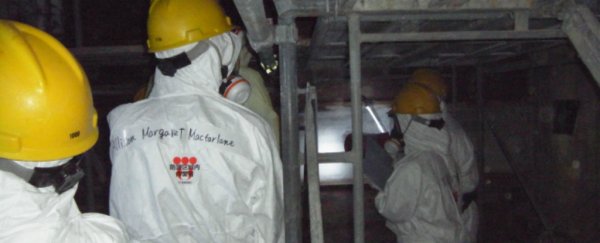A new radiation reading taken deep inside Japan's damaged Fukushima Daiichi nuclear reactor No. 2 shows levels reaching a maximum of 530 sieverts per hour, a number experts have called "unimaginable".
This reading was taken from the deepest point inside the reactor to date, which could explain why it's the highest level that's been recorded since the reactor was struck by a tsunami in March 2011 - but scientists aren't quite sure why this particular part of the reactor is so radioactive.
The previous maximum radiation level recorded in the reactor was 73 sieverts per hour. This latest reading from deep inside the reactor was more than seven times that amount.
There's been no official word from the Tokyo Electric Power Company (Tepco) about exactly what it is in this location that's caused this high reading. But the good news is that they say the radiation is safely contained within the reactor, so there's no risk to the greater population.
The latest readings were taken near the entrance of the No. 2 reactor, immediately below the pressure vessel that contains the reactor core. This is the first time radiation levels have been taken so far into the reactor.
To get an idea of the radiation levels inside the reactor, the team used a remote-operated camera to take photos of the area, and then analysed the electronic noise in the images to measure radiation levels.
The technique has an error margin of plus or minus 30 percent, which means that it's not highly accurate. But even at the lowest end of the measurements, the levels would still be 370 sieverts per hour - and could be as high as 690 sieverts per hour.
These unexpectedly high levels are complicating Tepco's plan to decommission the nuclear reactor. The most recent aim was to have workers find the fuel cells and start dismantling the plant by 2021 - a job that's predicted to take up to half a century.
But the levels within reactor No. 2, at least, are in no way safe for humans.
The Japanese National Institute of Radiological Sciences told Japan Times that medical professionals have no experience dealing with radiation levels this high - for perspective, a single dose of just 1 sievert of radiation could lead to infertility, hair loss, and sickness.
Four sieverts of radiation exposure in a short period of time would kill 50 percent of people within a month. Ten sieverts would kill a person within three weeks.
Even the remote-operated camera sent in to capture these images is only designed to withstand 1,000 sieverts of radiation, which means it won't last more than two hours once it gets this far inside No. 2 reactor.
It's not yet clear exactly what's causing the high levels at this spot, either. Because we haven't taken readings from this point before, it's possible that levels have always been this high and we just haven't known about it. Or maybe something inside the reactor has changed.
The fact that these readings were so high in this particular location suggests that maybe melted reactor fuel escaped the pressure vessel, and is located somewhere nearby.
Adding to that hypothesis is the fact that the images reveal a gaping 1-metre (3.2-foot) hole in the metal grate underneath the pressure vessel - which could indicate that nuclear fuel had melted out of it.
 Tepco
Tepco
On Monday, Tepco also saw "black chunks" deposited on the grating directly under the pressure vessel - which could be evidence of melted fuel rods.
If confirmed, this would be a huge deal, because in the six years since the three Fukushima reactors went into meltdown, no one has ever been able to find any trace of the nuclear fuel rods.
Swimming robots were sent into the reactors last year to search for the fuel rods and hopefully remove them, but their wiring was destroyed by the high levels of radiation.
Naturally, Tepco is reluctant to jump to any conclusions on what the black mass in the images could be until they have more information.
"It may have been caused by nuclear fuel that would have melted and made a hole in the vessel, but it is only a hypothesis at this stage," a Tepco spokesperson told AFP.
"We believe the captured images offer very useful information, but we still need to investigate given that it is very difficult to assume the actual condition inside."
Given the new readings, Tepco is now putting their plans to further explore reactor No. 2 using remote operated camera on hold, seeing as the device will most likely be destroyed by the intense conditions.
But they will send a robot into reactor No. 1 in March to try to get a better idea about the internal condition of the structure, while they decide what to do next with reactor No. 2.
Update 14 February 2017: This piece has been updated to clarify that the radiation levels in the reactor aren't necessarily increasing, simply that a reading has been made deeper inside the reactor than previously possible, and the levels are higher than expected.
